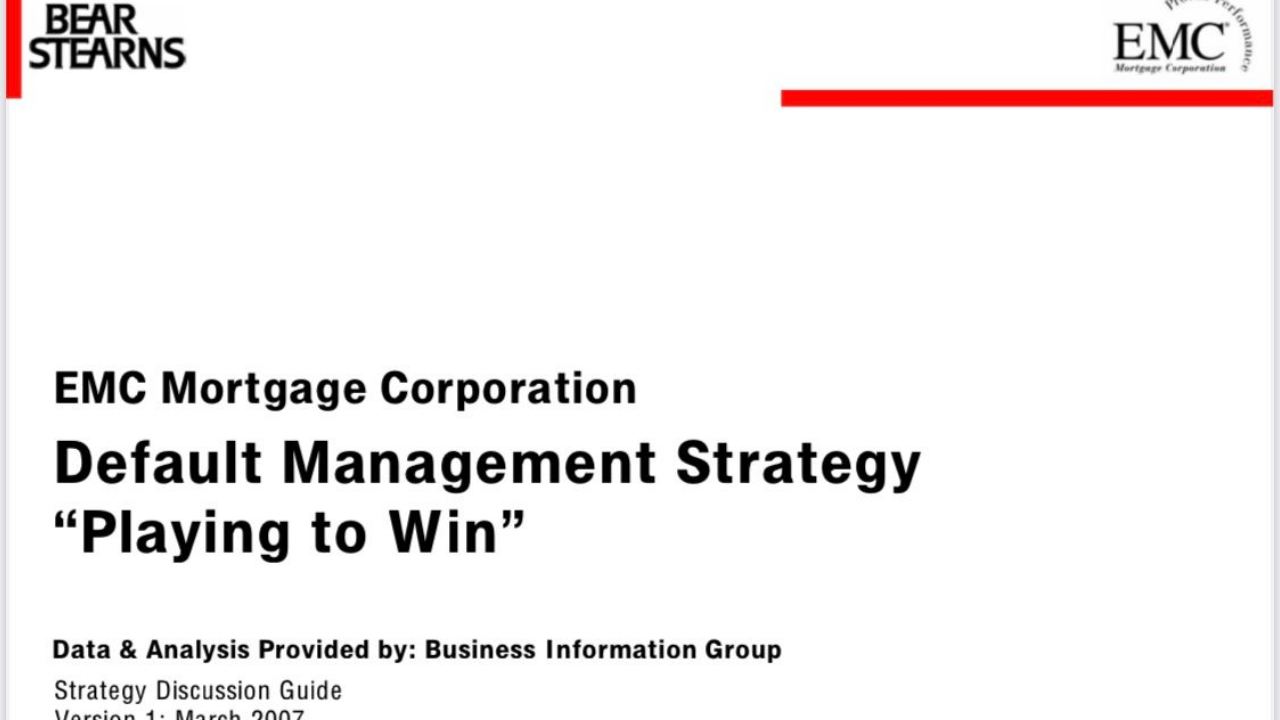“Steering Through the Storm: Strategies at Bear Stearns During the 2007 Subprime Reset"
Feb 27, 2025
A Look Back: My Experience at Bear Stearns During the 2007 Subprime Reset Wave
By Matt Slonaker
In early 2007, I was working at Bear Stearns as the MD/Head of Business Information Group inside their mortgage servicer, EMC, analyzing a portfolio of 24,065 subprime loans worth $4.5 billion, all scheduled to reset over the next seven months. These were mostly 2/28 and 3/27 adjustable-rate mortgages, and I knew the upcoming rate adjustments would challenge many borrowers.
Our analysis from that period, which I helped put together, offers a clear view of the situation we faced. Here’s my take on what I saw and the ten strategies I recommended to manage it.

My Perspective: Navigating a Tough Stretch
I spent a lot of time reviewing the data back then. Most of our loans—75%—were current, but 4.8% were 30 days late, 3.5% were 60+ days delinquent, and 18% were in foreclosure, bankruptcy, or listed as real estate-owned (REO) properties. The reset schedule showed big increases coming in May and August, with over 5,000 loans each month—$1.053 billion and $1.022 billion, respectively. Refinancing wasn’t a great option for many borrowers due to prepayment penalties and stricter lending rules.
I focused on a group of 13,400 loans we labeled the “Focus Group”—about 56% of the portfolio—where the risk of default was higher and prepayment less likely. These loans were tied to securities like BSABS 2005-HE10 and BSABS 2005-HE9. I also noticed regional patterns—places like Detroit had seen property values drop 59% from their original appraisals, and Atlanta had a lot of high loan-to-value loans. Our REO portfolio was another concern, with 27% of assets—1,525 properties—sitting unsold for 180 days or more, losing about 25% of their value on average.
It was a challenging time, no doubt. I worked with my team to break down the numbers—reset timelines, delinquency rates, even competitor practices—to figure out our next steps. I came up with ten strategies to propose to management, hoping to steady the ship. A year later, Bear Stearns was acquired by JPMorgan Chase in March 2008, but I still think about what we tried to do.
Ten Key Strategies
Here’s some of what was suggested, based on the analysis:
1. Focus on the Riskiest Loans
I highlighted the 13,400 Focus Group loans and recommended reviewing the pooling and servicing agreements for our BSABS HE deals—53% of the portfolio—to explore options like loan modifications, since refinancing was tough with low FICO scores (40% below 580) and penalties.
2. Move REO Properties Quicker
With 1,525 REO assets—27% of the portfolio—over 180 days old, I suggested speeding up sales, even if it meant lower prices. The 25% value drops, especially in markets like Detroit, made waiting costly.
3. Divide and Address the Portfolio
I split the loans into high-risk/low-prepay (17,593) and low-risk/high-prepay (6,472) groups. My idea was to encourage refinancing for the latter and prepare for defaults in the former, matching the approach to the risk.
4. Tailor Plans by Region
I looked at top metro areas like Chicago and LA, where CLTV risks ranged from 34.26% to 59.88% over 96%. I proposed regional adjustments, like extra loss mitigation efforts in high-CLTV areas like Dallas-Fort Worth and Houston.
5. Borrow from Competitors
I studied how firms like Litton and Countrywide managed defaults and used tech. I thought we could adopt some of their methods to improve our REO process and overall oversight.
6. Adjust Prepayment Penalties
With 71% of loans—$3.2 billion—having hard prepayment penalties, I suggested exploring waivers or changes to make refinancing easier, which could help borrowers and lower our default rates.
7. Prioritize High-Value REOs
I pointed out 165 REO assets over 180 days with values above $250,000. My recommendation was to focus on selling those first to recover more capital, despite softer market conditions.
8. Improve Management Efficiency
I noticed managers like Mark had 54% of their marketable assets over 180 REO days. I suggested tightening oversight and reallocating resources to smooth out inefficiencies.
9. Get Ahead of Reset Peaks
With big resets in May (5,216 loans) and August (5,133 loans), I proposed reaching out to borrowers early with options like temporary rate adjustments or foreclosure alternatives to manage the impact.
10. Explore More Options
Since 98% of our portfolio was subprime and refinancing was limited, I recommended looking into short sales, deeds-in-lieu, and servicer partnerships to give us more tools beyond foreclosure.
Reflecting on It Now
Those strategies were my data driven viewpoints at addressing the situation, but things moved fast. Bear Stearns’ heavy involvement in subprime markets, combined with wider industry pressures, led to its sale in 2008. Looking back, I see the warning signs I flagged—delinquencies, slow REOs, regional risks—and think about what we might have adjusted (note a year later I was given the opportunity by Vella & Little to lead the REO division).
Today, I take away a few simple lessons: act early, act on the data, keep things clear, and stay flexible. My work at Bear Stearns was a real-world education in managing change and risk, and while the outcome wasn’t what we hoped, it’s shaped how I approach crisis challenges ever since.
Fast Forward to Today: Top Five Strategies and Lessons for Mortgage Servicers in 2025
It’s February 27, 2025, and I’m reflecting on my time at Bear Stearns back in 2007, when we faced a subprime reset wave that shook the industry. The challenges we dealt with—rising delinquencies, aging REO inventories, and a market in flux—feel oddly familiar today. Mortgage servicers in 2025 are navigating a different but equally complex landscape: high interest rates lingering from Federal Reserve tightening, a stubbornly unaffordable housing market, and borrowers under financial strain, with 41% classified as financially healthy (down from 52% in 2022, per J.D. Power). Technology has evolved, but so have expectations—borrowers demand seamless digital experiences, and regulators keep raising the bar on compliance. Drawing from my Bear Stearns analysis and today’s realities, here are the top five strategies and lessons I’d suggest servicers apply now.
1. Leverage Technology for Efficiency and Borrower Experience
Then: In 2007, I saw how manual processes bogged us down—our REO sales were sluggish, and we couldn’t pivot fast enough. I recommended borrowing from competitors’ playbooks, like better tech for default management.
Now: Today, servicers face rising operational costs and borrower expectations for self-service. Automation and AI are game-changers—think robotic process automation (RPA) for repetitive tasks or chatbots handling inquiries 24/7. Lesson: Invest in real-time, flexible systems. Sagent’s work on hardship relief during the pandemic showed how tech can deliver fast, compliant solutions. With origination costs nearing $8,500 and servicing costs climbing, efficiency isn’t optional—it’s survival.
2. Prioritize Proactive Borrower Support
Then: I pushed for early outreach before the May and August reset spikes—temporary rate relief or foreclosure alternatives could’ve softened the blow. Too often, we reacted instead of anticipated.
Now: Borrowers today are stressed—rising escrow costs mean higher monthly payments, and delinquency rates hover at 3.94% (MBA data). Servicers can’t wait for defaults. Lesson: Get ahead with predictive analytics to spot at-risk borrowers and offer tailored solutions like payment deferrals or refinances. The 2020 crisis taught us that proactive relief retains customers and cuts losses—apply that now before the next hardship cycle hits.
3. Optimize REO and Default Management
Then: Our REO portfolio was a mess—27% of assets sat unsold for over 180 days, losing 25% of their value. I urged faster sales, especially for high-value properties, to recover capital.
Now: REO isn’t the monster it was in 2007, but defaults still cost five times more to service than performing loans (McKinsey). Markets like California and Florida still see slow turnovers due to affordability gaps. Lesson: Streamline disposition with data-driven pricing and partnerships—subservicers with digital-first approaches can move assets faster. Don’t let inventory drag you down.
4. Strengthen Retention Through Personalization
Then: I saw refinancing choked by prepayment penalties and subprime exposure—98% of our portfolio had nowhere to go. I suggested easing penalties to keep borrowers.
Now: Retention’s at a 16-year low—11% in 2023 (MBA)—and fintechs make switching easy. Borrowers don’t choose their servicer, so loyalty’s fragile. Lesson: Use data analytics to personalize offers—think rate-lock options or HELOCs tapping into $11 trillion in home equity (HousingWire). A J.D. Power score of 606 shows room to improve—make borrowers feel valued, not trapped.
5. Build Resilience Against Regulatory and Market Shifts
Then: We were blindsided by the speed of the subprime collapse—my regional risk profiling and creative mitigation ideas aimed to adapt, but the scale overwhelmed us.
Now: Servicers face tighter CFPB rules on disclosures, state-level reviews, and cyber threats (SAP Fioneer). Rates might dip to 6.3% by year-end (Fannie Mae), but volatility looms. Lesson: Stay agile—cloud platforms like Microsoft’s for Financial Services can scale compliance and security. My 2007 push for diversified options (short sales, servicer alliances) applies here: don’t bet on one outcome.
Looking Ahead
Back in 2007, I learned that preparation beats reaction every time—Bear Stearns didn’t fully heed that, and we paid the price. Today, servicers have better tools but face sharper challenges: a tech-savvy borrower base, cost pressures, and an uncertain economy with unemployment at 3.8% (still solid, but cracks are showing). My advice? Blend the urgency I felt then with 2025’s tech edge—act early, lean on data, and keep borrowers at the center. The storm’s different now, but the steering principles still hold.

interested to learn and explore more around the latest in operational transformation and revenue growth, then let’s meet!
Regards,
Matt
NICE TO MEET YOU
I'm Matt Slonaker
As the Founder of M. Allen, I empower B2B companies to achieve breakthrough sales in half the time. Leveraging strategic insights, proven methodologies, and a robust network, I have produced or overseen $200 million in new revenue opportunities for stakeholders.
With experience as a revenue, financial services C-suite executive leader, and a U.S. Navy combat veteran, I bring resilience and strategic insight to every project. My results-driven approach ensures that your goals are met and exceeded.
